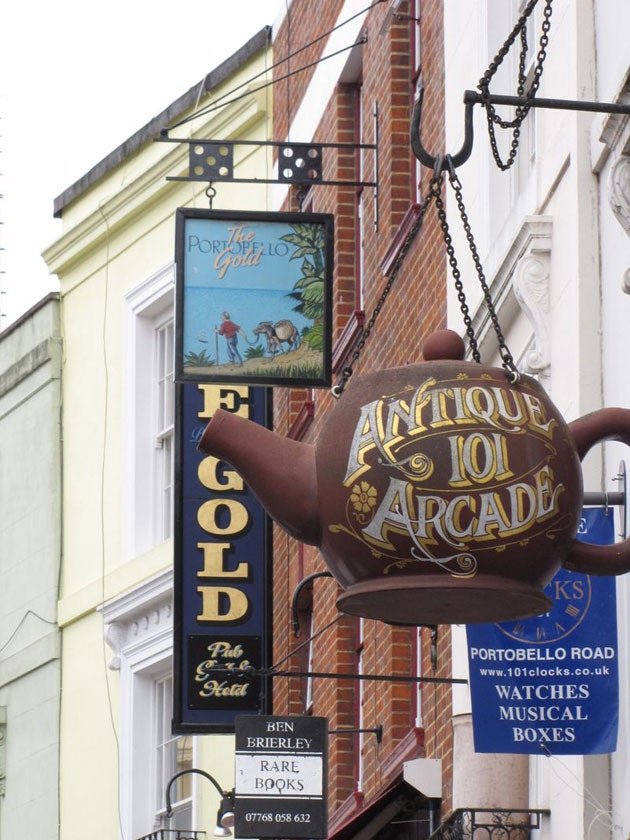What is the future for Britain’s antiques trade?

Last year, just weeks after celebrating the 75th annual Grosvenor House Art & Antiques Fair in June 2009, the organisers announced it was to close for good, citing declining profit, increased costs and demands on the space for closure.
Search for the perfect furniture with The Independent house and home database, powered by mydeco.
Meanwhile, Portobello Road traders are still up in arms after the chain store, All Saints, replaced the 40-stall Lipka antiques arcade this March, leaving more than 150 traders without a home.
"Small businesses are being priced out by landlords who have to get a return on their massive multi-million pound investments, whether it’s the exhibition space or the retail space, and the central government has done nothing to help," says Marion Gettleson, whose family has run Delahar antiques shop on Portobello Road for 50 years.
It's the tip of the iceberg in an industry that has been in decline for some time with a 21 per cent reduction in UK sales last year and the Antiques Collectors' Club Annual Furniture Index (AFI) reporting a 7 per cent fall in the price of antique furniture. This was the biggest ever 12-month drop in the index, said the Antiques Trade Gazette, which put the decline down to "lukewarm bidding at auction and things trading at retail outlets."
So where lies the future of antiques? Is the once thriving and peculiarly British trade on its way out, and with it the Baroque shop fronts, eccentric stall holders and rummaging punters? Have we really abandoned the paint-peeled mirror and rat-a-tat table; the painstakingly restored walnut chest and the beautifully made Georgian cabinet in favour of chip board and IKEA?
While whole communities, the integrity of our culture and the character of our streets will surely be destroyed if government and local councils do not look after the small businesses at their heart, there is still hope for the antiques trade more generally, which is showing signs of a beating heart online.
Last year, online auction site, the-saleroom.com, which enables local auctioneers to include online bidders in sales, reported a 120 per cent increase in bidder numbers and a rise in revenues of 55 per cent year-on-year. Anne Somers, CEO of ATG Media, which powers thesaleroom.com and provides information to the antiques industry, commented, "The-saleroom.com saw 717 live internet auctions take place in 2009, which is 49 per cent more than the previous year and the total value of lots sold was £8.6 million, an increase of 87 per cent on the previous year."
Anne reckons that professional and part-time dealers make up the bulk of thesaleroom.com bidders and that approximately 35 per cent would class themselves as collectors. The advantage of online auctions, she says, is that dealers and collectors “know more about what's going on in the country – and can buy in the remote areas."
Fairs, too, are becoming an increasingly important part of the antique furniture and fine art markets, with recent figures from the British Antique Dealers' Association suggesting more than a quarter of all sales are now completed at industry events, and new fairs cropping up all the time.
This month, the first Art Antiques London fair, set up by London-based international fair organisers, Brian and Anna Haughton, will take place between 9-16 June in a purpose-built marquee in Kensington Gardens. Meanwhile, the first Masterpiece London, which founders hope will become one of the most prestigious antiques shows in the calendar, will open between 24-29 June at the Former Chelsea Barracks. The new West London Art & Antiqes Fair, organised by Penman, has just taken place at Kensington Town Hall, and elsewhere, Arthur Swallow, organiser of the enormous antiques and collector's event at the Lincolnshire Showground, has announced that he will be launching two new antiques fairs this year, in Yorkshire and Derby.
While fairs and online auctions are in no way a replacement for the markets and smaller antique shops, which may not be able to afford to exhibit at fairs or pay the surcharges of auctions, these are buds of hope in a culture that is starting to protest about its "throwaway" name tag. While the Portobello traders fight for their livelihoods, an Antiques Are Green movement is underway, celebrating the longevity of antiques as things that will appreciate, rather than depreciate in value.
Tastes are changing, and the desire of people to seek and find something "hasn't gone away", says Marion. "Young people are aware that a vast amount of the material available for them to buy is just junk made for very little in the Far East and sold at inflated prices, but it nonetheless remains junk."
Buy a good antique and you're not only shopping in a more ethical and environmentally aware way, but you are likely to get most of your money back, if not more, when you come to sell it – let's hope that in this is still possible in the future.
Emily Jenkinson is interiors writer for furniture and interior design website mydeco.com.
Join our commenting forum
Join thought-provoking conversations, follow other Independent readers and see their replies
Comments
Bookmark popover
Removed from bookmarks